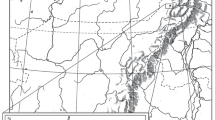Abstract
Plant remains, including both mega and micro collected from the middle part of the Tharumsa Foramtion (early Miocene) are described for the first time from the Tharumsa village of the Kargil district, Jammu and Kashmir to reconstruct the palaeoenvironment. They indicate their affinities with Broussonetia of the Moraceae and Abies, Cedrus and Pinus of the Pinaceae. Their presence indicates warm and moist tropical to sub-tropical climate in the Kargil area during the depositional period against the cold and dry climate prevailing at present.
Similar content being viewed by others
References
Bajpai, S., Whatley R.C.., Prasad, G.V.R. and Whittaker, V.E. (2004) An Oligocene non-marine ostracod fauna from the Basgo Formation (Ladakh Molasse), NW Himalaya, India. Jour. Micropalaeontol., v.23, pp.3–9.
Bhandari, L.L., Venkatachala, B.S. and Singh, P. (1977) Stratigraphy, palaeoecology and palaeontology of Ladakh Molasse Group in the Kargil Area. Proc. 4th Indian Colloq. Micropalaeontol. Strat., v.4, pp.127–133.
Dilcher, D.L. (1974) Approaches to the identification of angiosperm leaf remains. Bot. Rev., v.40, pp.1–157.
Ellis, B., Daly, D., Hickey, L.J., Johnson, K.R., Mitchell, J., Wilf, P. and Wing, S.L. (2009) Manual of Leaf Architecture. Cornell University Press, Ithaca, New York.
Frank, W., Gansser, A. and Trommsdorf, V. (1977) Geological observations in the Ladakh area (Himalayas): a preliminary report. Schweiz. Mineral. Petrogr. Mitt., v.57, pp.89–113.
Guleria, J.S., Thakur, V.C., Virdi, N.S. and Lakhanpal, R.N. (1983) A fossil wood of Prunus from the Kargil (= Liyan Formation) of Ladakh. In: Geology of Indus Suture Zone of Ladakh, Thakur and Sharma (Eds.), Wadia Inst. Himalayan Geol., Dehradun, pp.187–193.
Hickey, L.J. (1973) Classification of the architecture of dicotyledonous leaves. Amer. Jour. Bot., v.60, pp.17–33.
Kumar, K., Nanda, A.C. and Tiwari, B.N. (1996) Rodents from the Oligo-Miocene Kargil Formation, Ladakh, India: biochronologic and palaeobiogeographic implications. N. Jb. Geol. Paläont., v.202, pp.383–407.
Kumar, M., Ghosh, A.K., Ram-awatar and Mehrotra, R.C. (2012) Palynomorhs of Gondwanic affinities in the Oligocene-Miocene sediments of Kargil Molasse Group, Ladakh, India. Palaeobotanist, v.61, pp.165–176.
Lakhanpal, R.N., Gyan, P., Thussu, J.L. and Guleria, J.S. (1984) A fossil fan palm from the Liyan Formation of Ladakh (Jammu and Kashmir). Palaeobotanist, v.31, pp.201–207.
Lakhanpal, R.N., Sah, S.C.D., Sharma, K.K. and Guleria, J.S. (1983) Occurrence of Livistona in the Hemis Conglomerate horizon of Ladakh. In: Thakur and Sharma (Eds.), Geology of Indus Suture Zone of Ladakh. Wadia Inst. of Himalayan Geol., Dehradun, pp.179–185.
Mathur, N.S. (1983) Age of the Kargil Formation, Ladakh Himalaya. In: Thakur and Sharma (Eds.), Geology of Indus Suture Zone of Ladakh. Wadia Inst. Himalayan Geol., Dehradun, pp.145–150.
Mehrotra, R.C., Ram-Awatar, Sharma, A. and Phartiyal, B. (2007) A new palm leaf from the Indus Suture Zone, Ladakh Himalaya, India. Jour. Palaeontol. Soc. India, v.52, pp.159–162.
Nanda, A.S. and Sahni, A. (1990) Oligocene vertebrates from the Ladakh Molasse Group, Ladakh Himalaya: Palaeobiogeographic implications. Jour. Himalayan Geol., v.1, pp.1–10.
Nanda, A.S. and Sahni, A. (1998) Ctenodactyloid rodent assemblage from Kargil Formation, Ladakh Molasse Group; Age and palaeogeographic implications for the Indian subcontinent in the Oligo-Miocene. Geobios, v.31, pp.533–544.
Paul, S.K., Ram-Awatar, Mehrotra, R.C., Sharma, A., Phartiyal, B. and Dorjey, C.P. (2007) A new fossil palm leaf from the Hemis Formation of Ladakh, Jammu and Kashmir, India. Curr. Sci., v.92, pp.727–729.
Prasad, G.V.R., Bajpai, S., Singh, S. and Parmar, V. (2005) First cricetid rodent (Mammalia) from the Ladakh Molasse, Northwestern Himalaya, India: age implications. Himalayan Geol., v.26, pp.85–92.
Sahni, M.R. and Bhatnagar, N.C. (1962) Freshwater mollusca and plant remains from the Tertiaries of Kargil, Kashmir. Rec. Geol. Surv. India, v.87, pp.467–476.
Shanker, R., Padhi, R.N., Prakash, G., Thussu, J.L. and Das, R.M. (1982) The evolution of Indus Basin, Ladakh, India. Geol. Surv. India Misc. Publ., v.41, pp.157–172.
Shu, G. (1994) Broussonetia. In: Flora of China, v.5, Wu et al. (Eds.), p. 26 (English Edition, www.efloras.org).
Srikantia, S.V. and Razdan, M.L. (1980) Geology of the part of central Ladakh Himalaya with particular reference to Indus tectonic zone. Jour. Geol. Soc. India, v.21, pp.523–545.
Tewari, B.S. and Dixit, P.C. (1971) A new terrestrial gastropod from fresh-water beds of Kargil, Ladakh, J. & K. State. Bull. Indian Geologists’ Assoc., v.4, pp.61–67.
Tewari, B.S. and Sharma, S.P. (1972) Charophytes from Wakka River Formation, Kargil, Ladakh. Bull. Indian Geologists’ Assoc., v.5, pp.52–62.
Thakur, V.C. (1987) Plate tectonic interpretation of the western Himalaya. Tectonophysics, v.134, pp.91–102.
Tiwari, B.N. (2003) A late Eocene Juxia (Perissodactyla, Hyracodontidae) from Liyan Molasse, Eastern Ladakh, India. Jour. Palaeontol. Soc. India, v.48, pp.103–113.
Upadhyay, R., Ram-Awatar, Kar, R.K. and Sinha, A.K. (2004) Palynological evidence for the Palaeocene evolution for forearc basin, Indus Suture Zone, Ladakh, India. Terra Nova, v.16, pp.216–225.
Zheng, H., Wu. Y., Ding, J., Binion, D., Fu, W. and Reardon, R. (2004) Invasive plants of Asian origin established in the United States and their natural enemies, vol. 1. USDA Forest Service, Morgantown.
Author information
Authors and Affiliations
Corresponding author
Rights and permissions
About this article
Cite this article
Mehrotra, R.C., Kumar, M., Ghosh, A.K. et al. Plant remains from the Tharumsa Formation of Ladakh, India. J Geol Soc India 83, 647–652 (2014). https://doi.org/10.1007/s12594-014-0094-2
Received:
Accepted:
Published:
Issue Date:
DOI: https://doi.org/10.1007/s12594-014-0094-2




